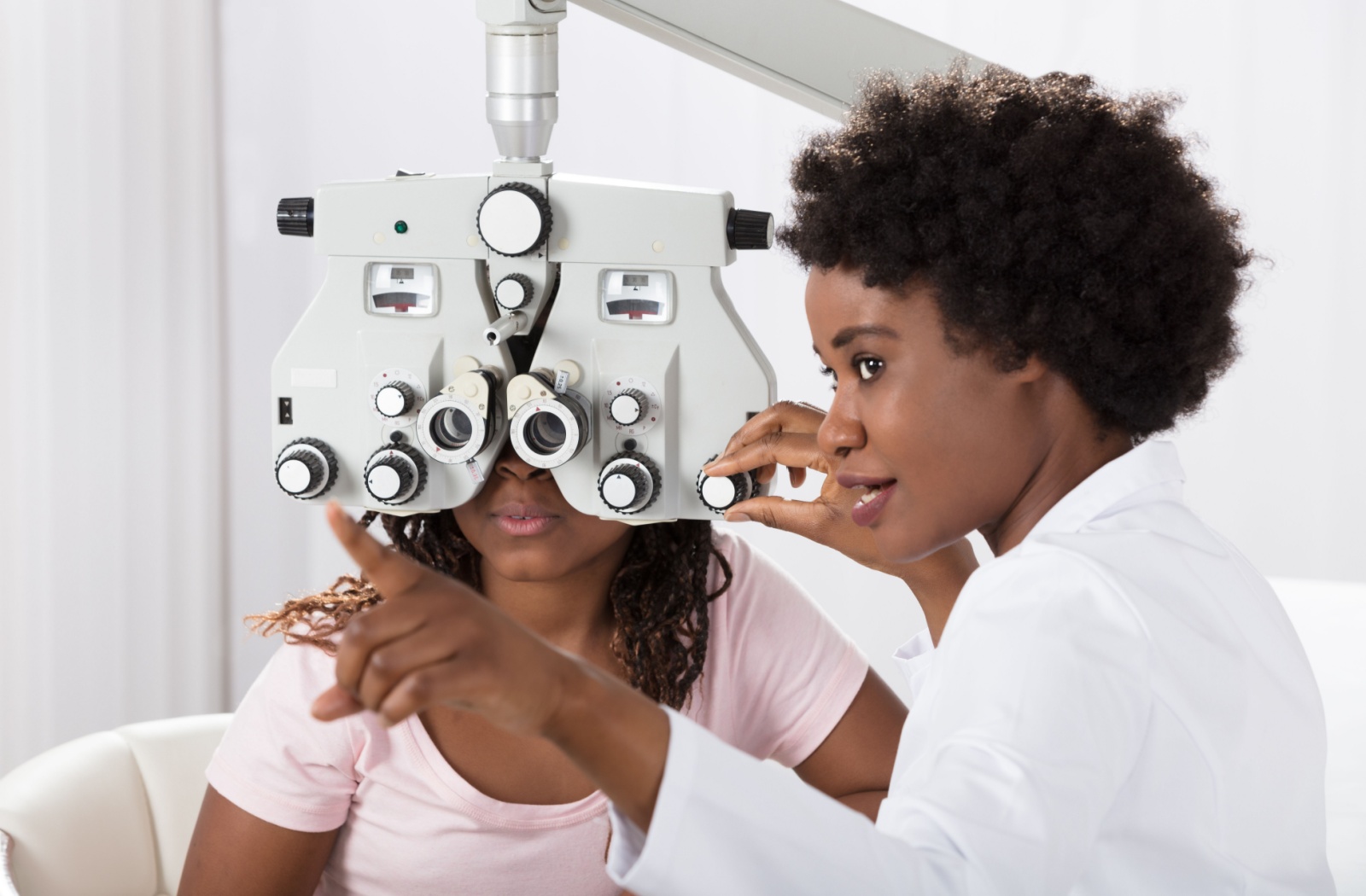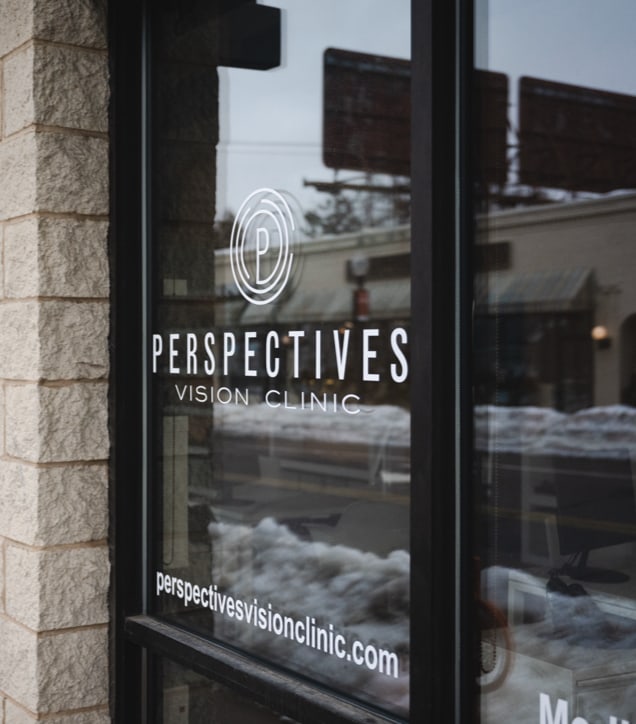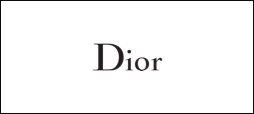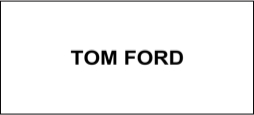Just as an annual physical exam helps monitor your body’s overall health, routine eye exams evaluate your vision and eye health.
Our eyes are even commonly referred to as the window of our souls. And, it may surprise you to learn there is some truth to this. Routine exams go beyond updating your vision prescription because our eyes show a glimpse of our overall health status.
From start to finish, your comprehensive eye exam can take around 30 minutes and include several tests:
- Preliminary testing
- Visual acuity
- Refraction exam
- Eye muscle function
- Pupil response check
- Slit lamp exam
- Retinal exam
No matter your results, our vision team is more than happy to clarify any questions or help you find your next set of frames!
Why You Need a Routine Eye Exam
Regardless of how sharp your vision feels, routine eye exams are necessary for everyone. Eye health isn’t just about seeing clearly, but also assessing what’s happening beneath the surface.
A good deal of health-related concerns develop without obvious symptoms until the condition progresses. Regular check-ins with your optometrist encourage early detection, which makes all the difference.
The frequency of your exams depends on several factors, including age, so, as a general rule:
- Children: Our eyes continue to grow and develop during childhood. Therefore, annual eye exams are encouraged for children 17 and under. Children can have their first eye exam as young as 6 months!
- Adults 18 to 64: Unless otherwise recommended, adults can get by with an exam every two years since our vision stabilizes during this time.
- Adults 65 and older: Older adults are more susceptible to age-related visual changes, which is why annual eye exams are recommended.
What to Expect During a Routine Eye Exam
Routine exams provide a comprehensive overview of your vision and eye health while being simple, gentle, and noninvasive.
The duration of your visit will depend on factors like your health status, family history, and the time since your last exam, but this usually takes around 30 minutes.
Preliminary Testing
Before entering the main exam room, you’ll undergo a series of preliminary tests and discuss your history and concerns.
We typically ask these questions so your doctor can better assess potential risk factors and customize the exam to your needs.
- Are you experiencing any vision problems or changes?
- Do you have a history of eye injuries or surgeries?
- Does your family have a history of eye diseases (e.g. glaucoma, macular degeneration)?
- Are you currently on any medications?
We perform 3 main preliminary tests, each of which provides a valuable baseline concerning different areas of your vision and eye health:
- Eye pressure test: This infamous air-puff test may feel startling, but it confirms your eye pressures are within a healthy range by checking for conditions like glaucoma.
- Auto-refraction: This assesses how light bends as it passes through your eye. This gives the doctor an estimate of your vision prescription and is further refined inside the exam room.
- Imaging: Modern imaging using OCT scans and retinal photos captures detailed pictures of your eye’s internal structures, which helps detect early signs of eye conditions.
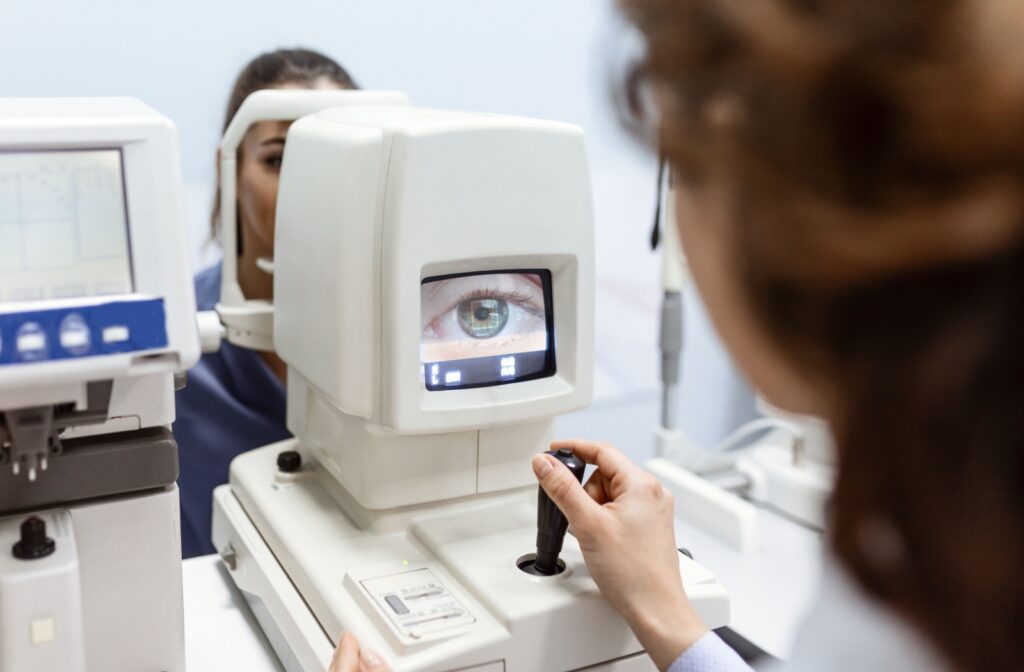
Visual Acuity Test
People are familiar with this part of the exam. It’s where you’ll read lines of letters (or shapes for children) from the Snellen chart.
This measures your visual clarity from a distance, typically recorded as a 20/20 number. For example, if your vision is 20/40, it means you can see at 20 feet what a person with no refractive error sees at 40 feet.
With this test, your optometrist can identify any changes in your vision and whether you’ll need an updated prescription for glasses or contacts.
Refraction Test
Your eye doctor works to determine how well your eyes focus to identify any refractive errors you may have using a series of lenses with a phoropter.
They will place different lenses in front of your eyes and ask, “Which is better, 1 or 2, both, neither, or do they look the same?” Your responses guide your optometrist toward finding the lens that provides the sharpest vision.
Eye Muscle Function Test
To evaluate how well your eyes work together, you will be asked to follow a pen or a small light with your gaze. This test checks the strength, alignment, and coordination of your eye muscles to identify focusing concerns like strabismus.
Proper eye muscle function helps with everyday tasks like reading, focusing on objects at different distances, and maintaining clear and comfortable vision throughout the day.
Pupil Response Check
Next, your optometrist will shine a light into your eyes to observe how your pupils constrict in bright light and dilate in dim light. These reactions are automatic and controlled by your brain, making them an indicator of your neurological health.
An abnormal response can signal issues like optic nerve damage, brain injuries, or other underlying conditions that may require further evaluation.
Slit Lamp Exam
A slit lamp is a microscope with a bright light designed to closely view your eye’s structures, including the cornea, iris, lens, and retina.
This allows them to detect any abnormalities or early signs of concern, like cataracts, macular degeneration, or corneal injuries.
Retinal Exam
Your doctor finishes the health evaluation by using an ophthalmoscope to get an in-depth look at the back of your eye.
Sometimes, special eye drops are used to dilate your pupils, making it easier to examine these structures for early signs of conditions like diabetic retinopathy or retinal detachment.
Keep Your Vision Healthy
Routine eye exams are a small but necessary investment for maintaining sharp vision and good eye health.
Consistently scheduling these checkups is more than updating your prescription. It’s a proactive way to detect and prevent serious concerns. If it’s been a while since your last eye exam, there’s no better time to book one than now. Connect with our Perspectives Vision Clinic team to schedule your next routine eye exam.
